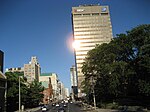Mohawk College
Mohawk College of Applied Arts and Technology is a public college of applied arts and technology located in Hamilton, Ontario. Established in 1966, the college currently has three main campuses: the Fennell Campus on the Hamilton Mountain, the Stoney Creek Campus in Stoney Creek, and the Mohawk-McMaster Institute for Applied Health Sciences at McMaster University. As of 2014, more than 1,000 faculty instructors, 12,500 full-time students, 4,000 apprentices, 46,000 continuing education registrants, and 1,800 international students have studied in more than 130 post-secondary and apprenticeship programs. Since its founding, over 115,000 students have graduated from Mohawk College.
Excerpt from the Wikipedia article Mohawk College (License: CC BY-SA 3.0, Authors).Mohawk College
Fennell Avenue West, Hamilton
Geographical coordinates (GPS) Address External links Nearby Places Show on map
Geographical coordinates (GPS)
| Latitude | Longitude |
|---|---|
| N 43.238222222222 ° | E -79.885688888889 ° |
Address
Mohawk College (Mohawk College - Fennell Campus)
Fennell Avenue West
L9C 0E3 Hamilton
Ontario, Canada
Open on Google Maps






